MLモデルと解釈性 "Weighted SHAP" 実装と解説
WeightedSHAP: analyzing and improving Shapley based
Yongchan Kwon, James Zou
NeurIPS 2022
https://arxiv.org/abs/2209.13429
表データを用いた回帰モデルの解釈性について勉強していてSHAPに興味を持ったので、最近NIPSで見たWeightedSHAPをツールとして使うための数式部分を理解して行きます。
図は論文からの引用です。
公式リポジトリ
この論文が言いたいこと
SHAPはMLモデルの予測値を特徴量方面から解釈するときに重要だが、元々ゲーム理論から発展した手法のためMLでは自然ではない公理からくる解釈があり、特に特徴量列にデータの多寡があるとShapley値を求めるときの単純な線形和
これに対処するため、WeightedSHAPではShapley値の特徴の帰属(feature attribution)の数学的な解析と、影響力の低い特徴に対してより大きな帰属を割り当てるという最適でない状況を特定し、この洞察を基にShapley値の一般化と、データから直接どの限界貢献にフォーカスするかを学習する手法を提案しており、モデルの予測をよりよく再現(つまりSHAP値による分解が正確に)できるようにした。
例えば線形モデルや決定木は解釈性が高く、回帰係数やノードの条件などから予測値を理解することができるが、最近のDNNやランダムフォレストなどの方法は解釈に関して直感的でない。これをモデルを弄らずに特徴量と推論を使って解釈する方法が[1]のSHapley Additive exPlanations (SHAP)であり、これはShaply値が満たす理論的性質が良いため支持されているが、計算コストの高さはネックである。
元論文の主な貢献点:
- SHAPの限界貢献の分析によりShaply値の非最適性を示したこと
- 柔軟なShaply値の一般化であるWeightedSHAPを提案したこと
Shaply値のただの和を用いた解釈では、異なる限界貢献が異なるシグナル(?)とノイズを持つ場合に帰属誤り(attribution mistakes)を起こすことがあり、これを正すためにデータから加重平均の重みを学習する方法を提案している。
また単純な変更であるため、従来のSHAPの実装からすぐに変更できる。
[1] Scott M Lundberg and Su-In Lee. A unified approach to interpreting model predictions. In Proceedings of the 31st international conference on neural information processing systems, pages 4768-4777, 2017.
そもそもSHAPとは
まず限界貢献とShapley値について振り返る。
- 入力次元
d ∈ \mathbb{N} - 入力空間
\mathcal{X} ⊆ \mathbb{R}^{d} - 出力空間
\mathcal{Y} ⊆ \mathbb{R} - 確率変数
X = (X_{1}, \dots X_{d}) ∈ \mathcal{X} - 実現値
x = (x_{1}, \dots x_{d}) - モデル
\hat{f} : \mathcal{X} → \mathcal{Y} - 集合
[j] := {1, \dots j} 2^{[j]} - ベクトル
u ∈ \mathbb{R}^{d} S := (j_{1}, \dots j_{|S|} ⊆ [d]) u_{S} := (u_{\substack{j\\1}}, \dots u_{\substack{j\\|S|}}) -
X S ⊊ [d] p(X_{[d]\backslash S} | X_{S}) p(X)
以上の前提で、[2]で定義される条件付き提携関数(conditional coalition function)
条件付き提携関数
ここで
v^{(\text{cond})} (\empty) := 0 v^{(\text{cond})} ([d]) := \hat{f}(x) - \mathbb{E}[\hat{f}(X)]
上の2つは慣例に従った定義であるが、つまるところ無情報の時は
[2] Scott M Lundberg and Su-In Lee. A unified approach to interpreting model predictions. In Proceedings of the 31st international conference on neural information processing systems, pages 4768-4777, 2017.
限界寄与に基づく帰属法(attribution methods)
「SHAPは何をしたいか」について立ち戻ると、予測値
まず、ある特徴を1つ追加した後の
限界貢献(Marginal contribution)
次のように定義される。
雑に言うと、
さらに、[3]などで使われるShapley値を用いる方法として次の定義が使える。
雑に言うと、特徴量
以下は筆者が理解できていない部分であるが雑に訳してメモしておく...
Shaply値は協力ゲーム理論におけるfair divisionの4つの公理を満たす唯一の関数として定義されるが、公理の経済的概念が帰属問題に直感的に適用できないことがあるという重大な問題があるらしい。
例えば帰属の総和が限界貢献度の中の
また、評価指標として包含AUC (area under the receiver operating characteristic curve)がよく知られている。まず帰属値に基づいて特徴がランク付けされ、次にAUCが最も影響力のある特徴から最も影響力のない特徴まで1つずつ追加することによって繰り返し評価されることで、追加した特徴数の関数としてAUC曲線が生成され、包含AUCはこの曲線下の面積として定義される。また同様の評価手法としてAUP (Area under the prediction recovery error curve)も使われている。
- 入力
x ∈ \mathcal{X} k ∈ [d] - 帰属法
φ(x_j) k \mathcal{L}(k; φ,x) ⊆ [d]
[3] Scott M Lundberg and Su-In Lee. A unified approach to interpreting model predictions. In Proceedings of the 31st international conference on neural information processing systems, pages 4768-4777, 2017.
限界貢献の閉形式の式
設定は以下。
- モデル
\hat{f} \hat{f}(x) = \hat{β}_{0} + x^{\top} \hat{β} (\hat{β}_{0}, \hat{β}) ∈ \mathbb{R} × \mathbb{R}^{d} - 共分散次元
B ∈ \mathbb{N} - 共分散行列
Σ_{\bold{ρ},\bold{d}}^{(\text{block})} = \text{diag}(Σ_{\bold{ρ}_{1},\bold{d}_{1}}, \dots Σ_{\bold{ρ}_{B},\bold{d}_{B}}) -
\bold{d} := (d_{1}, \dots d_{B}) ∈ \mathbb{N}^{B} \sum \bold{d} = d \bold{ρ} := (ρ_{1}, \dots ρ_{B}) ∈ [0,1)^{B} Σ_{\bold{ρ}_{b},\bold{d}_{b}} = (1 - ρ_{b}) I_{d_{b}} + ρ_{b} \mathbb{i}_{d_{b}} \mathbb{i}_{d_{b}}^{\top} -
i×i I_{i} - 全要素が1の
i \mathbb{i}_{i}
すなわち、
- 各特徴は単位分散を持つように正規化されている
- 各特徴は
B - 例えば
j ∈ [B] j d_{j}
通常、限界貢献は閉形式の式を持たないが、上記の設定においては限界貢献
i,j ∈ [d] -
H(i,j)
この定理は限界貢献が入力
bilinearだと計算効率が劇的に改善するためうれしい。式の通り、
最適な帰属が計算できない例
まず
\mathcal{E}(k_{=\{1,2\}}; x, \hat{f}) = | \hat{f}(x_1, x_2) - \mathbb{E}[(\hat{f}(X_1,X_2) | X_k = x_k)] | \text{APU}(φ; x, \hat{f}) = \mathcal{E}(1; x, \hat{f}) \space \texttt{if} \space (\mathcal{L}(1; φ,x)=\{1\}) \space \texttt{else} \space \mathcal{E}(2; x, \hat{f})
例えば、
しかし、次の図では最適な順序を用いてもShapley値が必ず影響力通りに帰属されるわけではない場合が示されている。この最適でない領域は特徴量の相関が大きくなるにつれて増加し、相関が高い場合にShapley値に基づく説明可能性が悪化していることがわかる。これは
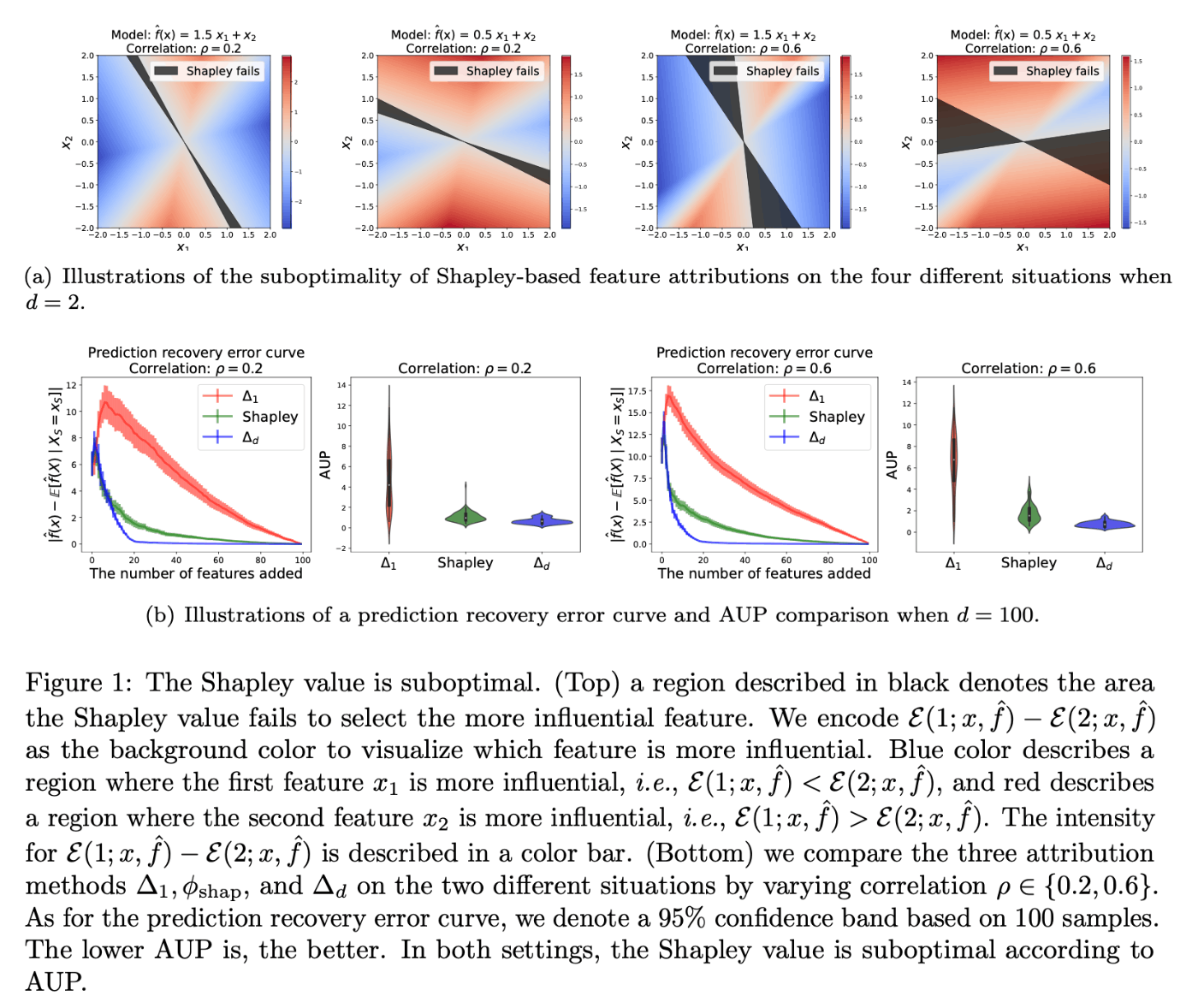
どのシーンでも、Shapley値がより影響力のある特徴を選択できない無視できない黒い領域が存在する。
WeightedSHAP
線形モデルを仮定した理論解析とシミュレーションの結果、特徴の相関が高い場合にShapley値が影響力のある特徴を選択できないようなシーンが出てきて、説明性が低くなるという結果が示された。
これを改善するため、限界貢献度の推定誤差を検討することで、限界貢献の加重平均を行う。
推定誤差の分析
Shapley値を推定するにあたり推定誤差が生じるが、この数学的定義から考えると推定誤差は限界貢献の推定誤差から生じている。
限界貢献の推定誤差について考えると、これは
次の図は定理から導かれる限界貢献
これにより、シグナルを維持しながら推定誤差を減らすため、限界寄与の加重平均を考えるモチベーションが生まれてくる。
提案手法
これはゲーム理論において半価値の意味になっている式だが、効率公理(efficiency axiom)を満たす性質は帰属タスクではどうでもいい[4]ため、これを緩和することで一意性を犠牲に重み選択できるようにする。
この重み選択は下流タスクで選択することが望ましいらしいため、使用者が定義できるようにする。
- 重みの族
\mathcal{W} ⊆ \{ w ∈ \mathbb{R}^d : \sum_{j=1}^{d} w_j = 1, w_j > 1 \} - 帰属法を入力とし、そのutilityを出力するユーザ定義の関数
\mathcal{T} -
\mathcal{T} \bold{w}*(\mathcal{T},\mathcal{W}) := \text{argmax}_{w ∈ \mathcal{W}}\mathcal{T}( φ_{\bold{w}} )
この設定によって、WeightedSHAPが提案される。
例えば negative AUPを
[4] Mustapha Ridaoui, Michel Grabisch, and Christophe Labreuche. An axiomatisation of the banzhaf value and interaction index for multichoice games. In International Conference on Modeling Decisions for Artificial Intelligence, pages 143-155. Springer, 2018.
実装
重要な部分は、限界貢献の集合を推定すること、つまり
まず
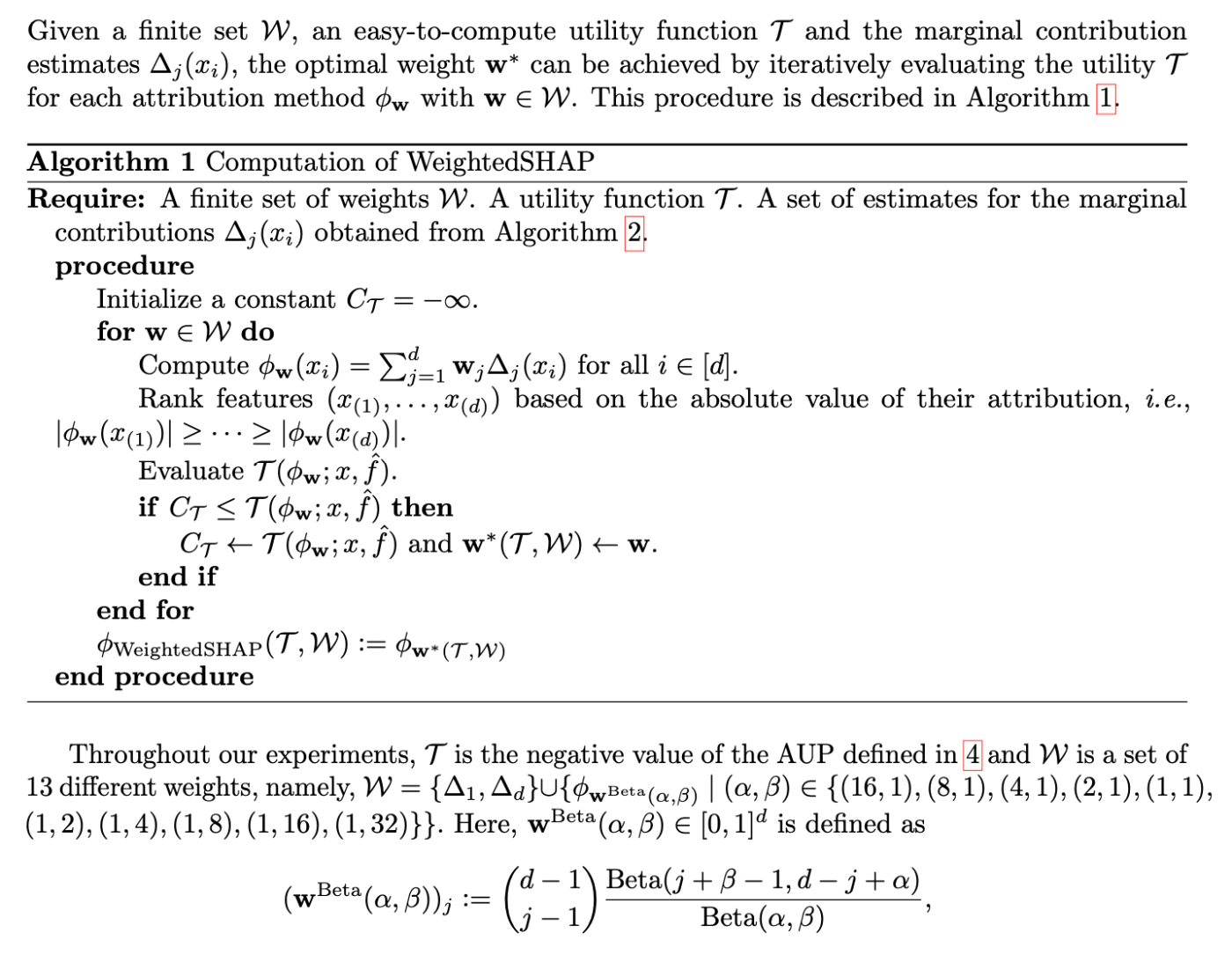
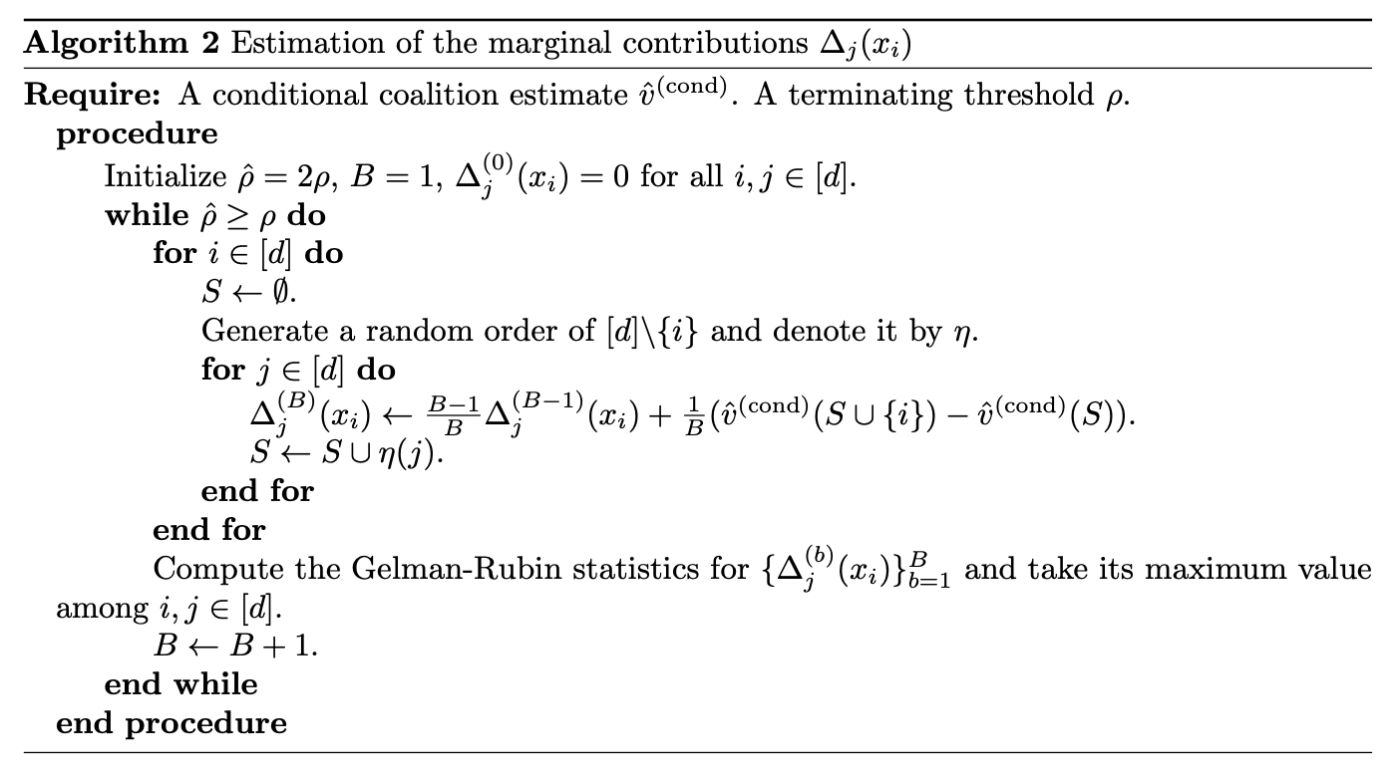
[5] Christopher Frye, Damien de Mijolla, Tom Begley, Laurence Cowton, Megan Stanley, and Ilya Feige. Shapley explainability on the data manifold. arXiv preprint arXiv:2006.01272, 2020.
[6] Neil Jethani, Mukund Sudarshan, Ian Covert, Su-In Lee, and Rajesh Ranganath. Fastshap: Real-time shapley value estimation. arXiv preprint arXiv:2107.07436, 2021a.
[7] Amirata Ghorbani and James Zou. Data shapley: Equitable valuation of data for machine learning. In International Conference on Machine Learning, pages 2242-2251. PMLR, 2019.
[8] Yongchan Kwon and James Zou. Beta shapley: a unified and noise-reduced data valuation framework for machine learning. arXiv preprint arXiv:2110.14049, 2021.
実際のコードを眺めてみる。見やすさのため適宜改行などの改変をした。
Compute WeightedSHAP
weightedSHAP.generate_coalition_functioncreates a conditional coalition function that computes conditional expectation values\mathbb{E} [f(X) \mid X_S = x_S] weightedSHAP.compute_attributionscomputes WeightedSHAP>\phi_{\mathrm{WeightedSHAP}}(\mathcal{T}, \mathcal{W}) := \phi_{\mathbf{w}^* (\mathcal{T}, \mathcal{W})}, > where
. By default, a set \mathbf{w}^* (\mathcal{T}, \mathcal{W}) := \mathrm{argmax}_{\mathbf{w} \in \mathcal{W}} \mathcal{T} (\phi_{\mathbf{w}}) includes SHAP and \mathcal{W} is the negative area under the prediction recovery error curve (AUP, Equation (4) of the paper). \mathcal{T}
problem = 'classification'
dataset = 'fraud'
ML_model = 'boosting'
# train a baseline model
model_to_explain = weightedSHAP.create_model_to_explain(
X_train, y_train,
X_val, y_val,
problem,
ML_model
)
# Generate a conditional coalition function
conditional_extension = weightedSHAP.generate_coalition_function(
model_to_explain,
X_train, X_est,
problem,
ML_model
)
# With the conditional coalition function, we compute attributions
exp_dict = weightedSHAP.compute_attributions(
problem,
ML_model,
model_to_explain, conditional_extension,
X_train, y_train,
X_val, y_val,
X_test, y_test)
Analysis on WeightedSHAP
The output of weightedSHAP.compute_attributions includes
-
value_list: A list of WeightedSHAP values -
true_list: A list of true labels -
pred_list: A list of predictions -
input_list: A list of inputs -
cond_pred_keep_absolute: Conditional expectation of predictions. Features with large absolute values are added first.
exp_dict.keys()
# -> ['value_list', 'true_list', 'pred_list', 'input_list', 'cond_pred_keep_absolute']
y_test=np.array(exp_dict['true_list'])
pred_list=np.array(exp_dict['pred_list'])
print(f'MSE of the original model: {np.mean((y_test-pred_list)**2):.3f}')
# -> MSE of the original model: 0.226
最も興味のある部分として計算部分のメソッドを見てみる。外部のモジュールはすべて展開して書いた。
計算部分
import tqdm
import numpy as np
def check_convergence(mem, n_require=100):
"""
Compute Gelman-Rubin statistic
Ref. https://arxiv.org/pdf/1812.09384.pdf (p.7, Eq.4)
"""
if len(mem) < n_require:
return 100
n_chains=10
(N, n_to_be_valued) = mem.shape
if (N % n_chains) == 0:
n_MC_sample = N//n_chains
offset = 0
else:
n_MC_sample = N//n_chains
offset = (N % n_chains)
mem = mem[offset:]
percent = 25
while True:
IQR_contstant = np.percentile(mem.reshape(-1), 50+percent) - np.percentile(mem.reshape(-1), 50-percent)
if IQR_contstant == 0:
percent = (50+percent)//2
if percent >= 49:
assert False, 'CHECK!!! IQR is zero!!!'
else:
break
mem_tmp = mem.reshape(n_chains, n_MC_sample, n_to_be_valued)
GR_list = []
for j in range(n_to_be_valued):
mem_tmp_j_original = mem_tmp[:,:,j].T # now we have (n_MC_sample, n_chains)
mem_tmp_j = mem_tmp_j_original/IQR_contstant
mem_tmp_j_mean = np.mean(mem_tmp_j, axis=0)
s_term = np.sum((mem_tmp_j-mem_tmp_j_mean)**2)/(n_chains*(n_MC_sample-1)) # + 1e-16 this could lead to wrong estimator
if s_term == 0:
continue
mu_hat_j = np.mean(mem_tmp_j)
B_term = n_MC_sample*np.sum((mem_tmp_j_mean-mu_hat_j)**2)/(n_chains-1)
GR_stat = np.sqrt((n_MC_sample-1)/n_MC_sample + B_term/(s_term*n_MC_sample))
GR_list.append(GR_stat)
GR_stat = np.max(GR_list)
print(f'Total number of random sets: {len(mem)}, GR_stat: {GR_stat}', flush=True)
return GR_stat
def compute_predict(model_to_explain, x, problem, ML_model):
if (ML_model == 'linear') and (problem == 'classification'):
return float(model_to_explain.predict_proba(x)[:,1])
else:
return float(model_to_explain.predict(x))
def beta_constant(a, b):
"""
the second argument (b; beta) should be integer in this function
"""
beta_fct_value = 1/a
for i in range(1,b):
beta_fct_value = beta_fct_value*(i/(a+i))
return beta_fct_value
def compute_weight_list(m, alpha=1, beta=1):
"""
Given a prior distribution (beta distribution (alpha,beta))
beta_constant(j+1, m-j) = j! (m-j-1)! / (m-1)! / m # which is exactly the Shapley weights.
# weight_list[n] is a weight when baseline model uses 'n' samples (w^{(n)}(j)*binom{n-1}{j} in the paper).
"""
weight_list=np.zeros(m)
normalizing_constant=1/beta_constant(alpha, beta)
for j in np.arange(m):
# when the cardinality of random sets is j
weight_list[j]=beta_constant(j+alpha, m-j+beta-1)/beta_constant(j+1, m-j)
weight_list[j]=normalizing_constant*weight_list[j] # we need this '/m' but omit for stability # normalizing
return weight_list/np.sum(weight_list)
def compute_semivalue_from_MC(marginal_contrib, semivalue_list):
"""
With the marginal contribution values, it computes semivalues
"""
semivalue_dict = {}
n_elements=marginal_contrib.shape[0]
for weight in semivalue_list:
alpha, beta=weight
if alpha > 0:
model_name=f'Beta({beta},{alpha})'
weight_list = compute_weight_list(m=n_elements, alpha=alpha, beta=beta)
else:
if beta == 'LOO-First':
model_name = 'LOO-First'
weight_list = np.zeros(n_elements)
weight_list[0] = 1
elif beta == 'LOO-Last':
model_name = 'LOO-Last'
weight_list = np.zeros(n_elements)
weight_list[-1] = 1
if len(marginal_contrib.shape) == 2:
semivalue_tmp = np.einsum('ij,j->i', marginal_contrib, weight_list)
else:
# classification case
semivalue_tmp = np.einsum('ijk,j->ik', marginal_contrib, weight_list)
semivalue_dict[model_name] = semivalue_tmp
return semivalue_dict
def compute_cond_pred_list(attribution_dict, game, more_important_first=True):
n_features = game.players
n_max_features = n_features # min(n_features, 200)
cond_pred_list = []
for method in attribution_dict.keys():
cond_pred_list_tmp = []
if more_important_first is True:
# more important to less important (large to zero)
sorted_index = np.argsort(np.abs(attribution_dict[method]))[::-1]
else:
# less important to more important (zero to large)
sorted_index = np.argsort(np.abs(attribution_dict[method]))
for n_top in range(n_max_features+1):
top_index = sorted_index[:n_top]
S = np.zeros(n_features, dtype=bool)
S[top_index] = True
# prediction recovery error
cond_pred_list_tmp.append(game(S))
cond_pred_list.append(cond_pred_list_tmp)
return cond_pred_list
class PredictionGame:
"""
Cooperative game for an individual example's prediction.
Reference: https://github.com/iancovert/removal-explanations/blob/main/rexplain/behavior.py
Args:
extension: model extension (see removal.py).
sample: numpy array representing a single model input.
"""
def __init__(self, extension, sample, superpixel_size=1):
# Add batch dimension to sample.
if sample.ndim == 1:
sample = sample[np.newaxis]
# elif sample.shape[0] != 1:
# raise ValueError('sample must have shape (ndim,) or (1,ndim)')
self.extension = extension
self.sample = sample
self.players = np.prod(sample.shape)//(superpixel_size**2)//sample.shape[0] # sample.shape[1]
# Caching.
self.sample_repeat = sample
def __call__(self, S):
# Return scalar if single subset.
single_eval = (S.ndim == 1)
if single_eval:
S = S[np.newaxis]
input_data = self.sample
else:
# Try to use caching for repeated data.
if len(S) != len(self.sample_repeat):
self.sample_repeat = self.sample.repeat(len(S), 0)
input_data = self.sample_repeat
# Evaluate.
output = self.extension(input_data, S)
if single_eval:
output = output[0]
return output
semivalue_list = [
(-1,'LOO-First'), (1,32), (1,16), (1, 8), (1, 4), (1, 2),
(1,1), (2,1), (4,1), (8, 1), (16, 1), (32,1), (-1,'LOO-Last')
]
attribution_list = [
'LOO-First', 'Beta(32,1)', 'Beta(16,1)', 'Beta(8,1)',
'Beta(4,1)', 'Beta(2,1)', 'Beta(1,1)', 'Beta(1,2)',
'Beta(1,4)', 'Beta(1,8)', 'Beta(1,16)', 'Beta(1,32)', 'LOO-Last'
]
def MarginalContributionValue(
game,
thresh=1.005,
batch_size=1,
n_check_period=100
):
"""
Calculate feature attributions using the marginal contributions.
"""
# index of the added feature, cardinality of set
arange = np.arange(batch_size)
output = game(np.zeros(game.players, dtype=bool))
MC_size = [game.players, game.players] + list(output.shape)
MC_mat = np.zeros(MC_size)
MC_count = np.zeros((game.players, game.players))
converged = False
n_iter = 0
marginal_contribs = np.zeros([0, np.prod([game.players] + list(output.shape))])
while not converged:
for _ in range(n_check_period):
# Sample permutations.
permutations = np.tile(np.arange(game.players), (batch_size, 1))
for row in permutations:
np.random.shuffle(row)
S = np.zeros((batch_size, game.players), dtype=bool)
# Unroll permutations.
prev_value = game(S)
marginal_contribs_tmp = np.zeros(([batch_size, game.players] + list(output.shape)))
for j in range(game.players):
"""
Marginal contribution estimates with respect to j samples
j = 0 means LOO-First
"""
S[arange, permutations[:, j]] = 1
next_value = game(S)
MC_mat[permutations[:, j], j] += (next_value - prev_value)
MC_count[permutations[:, j], j] += 1
marginal_contribs_tmp[arange, permutations[:, j]] = (next_value - prev_value)
# update
prev_value = next_value
marginal_contribs = np.concatenate([marginal_contribs, marginal_contribs_tmp.reshape(batch_size,-1)], axis=0)
if (n_iter+1) == 100:
converged=True
elif (n_iter+1) >= 2:
if check_convergence(marginal_contribs) < thresh:
print(f'Therehosld: {int(0.999*(game.players*n_check_period))}')
converged = True
else:
pass
n_iter += 1
print(f'We have seen {((n_iter+1)*n_check_period*batch_size)} random subsets for each feature.')
if len(MC_mat.shape) != 2:
# classification case
MC_count = np.repeat(MC_count, MC_mat.shape[-1], axis=-1).reshape(MC_mat.shape)
return MC_mat, MC_count
def compute_attributions(
problem,
ML_model,
model_to_explain,
conditional_extension,
X_test, y_test,
n_max=100
):
"""
Compute attribution values and evaluate its performance
"""
pred_list, pred_masking = [], []
cond_pred_keep_absolute, cond_pred_remove_absolute=[], []
value_list = []
n_max = min(n_max, len(X_test))
for ind in tqdm.tqdm(range(n_max)):
# Store original prediction
original_pred = compute_predict(model_to_explain, X_test[ind,:].reshape(1,-1), problem, ML_model)
pred_list.append(original_pred)
# Estimate marginal contributions
conditional_game = PredictionGame(conditional_extension, X_test[ind, :])
MC_conditional_mat, MC_conditional_count = MarginalContributionValue(conditional_game)
MC_est = np.array(MC_conditional_mat/(MC_conditional_count+1e-16))
# Optimize weight for WeightedSHAP (By default, AUP is used)
attribution_dict_all = compute_semivalue_from_MC(MC_est, semivalue_list)
cond_pred_keep_absolute_list = compute_cond_pred_list(attribution_dict_all, conditional_game)
AUP_list = np.sum(np.abs(np.array(cond_pred_keep_absolute_list)- original_pred), axis=1)
WeightedSHAP_index = np.argmin(AUP_list)
value_list.append(attribution_dict_all[attribution_list[WeightedSHAP_index]])
"""
Evaluation
"""
# Conditional prediction from most important to least important (keep absolte)
cond_pred_keep_absolute_list = compute_cond_pred_list(attribution_dict_all, conditional_game)
cond_pred_keep_absolute.append(cond_pred_keep_absolute_list)
exp_dict=dict()
exp_dict['value_list'] = value_list
exp_dict['true_list'] = np.array(y_test)[:n_max]
exp_dict['pred_list'] = np.array(pred_list)
exp_dict['input_list'] = np.array(X_test)[:n_max]
exp_dict['cond_pred_keep_absolute'] = np.array(cond_pred_keep_absolute)
return exp_dict
実験結果
marginal contribution feature importance (MCI) や予測回復誤差タスク、包含性能タスクにおけるShapley値と比較し、与えられた特徴量の数でモデルの予測値がどれだけ回復するかを測定することで、帰属の良さを評価する。
モデルの性能については、回帰問題ではMSE、分類問題ではAUCを評価する。
-
v^{(\text{cond})} -
\mathcal{T} -
\mathcal{W} Δ_1, Δ_d, φ_{\text{shap}}
この設定でWeightedSHAP(赤)、 MCI(青)、Shapley値(緑)の予測回復誤差曲線をプロットしたものが次の図である。
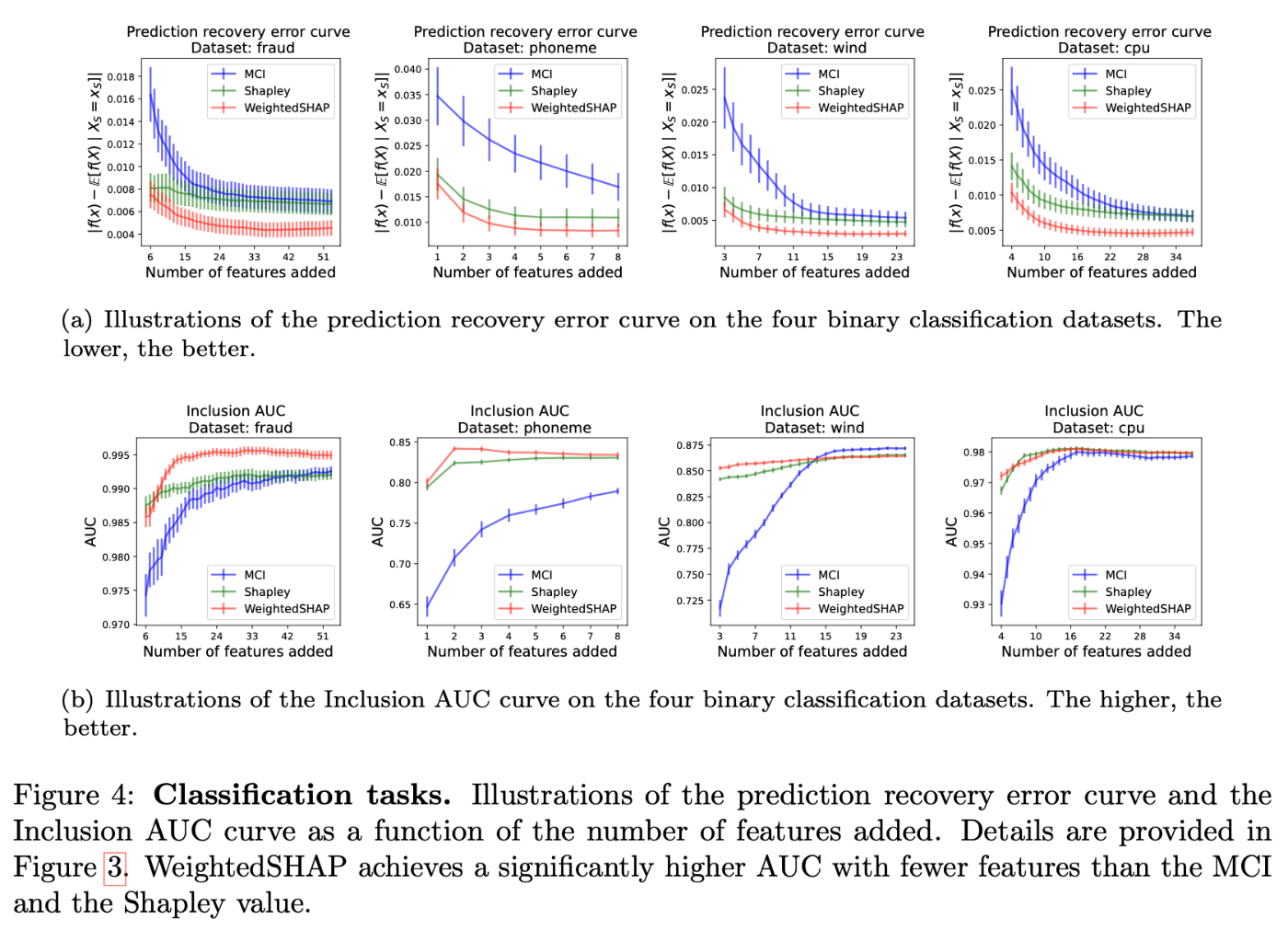
また、画像タスクにおいてCNNの評価を行った。
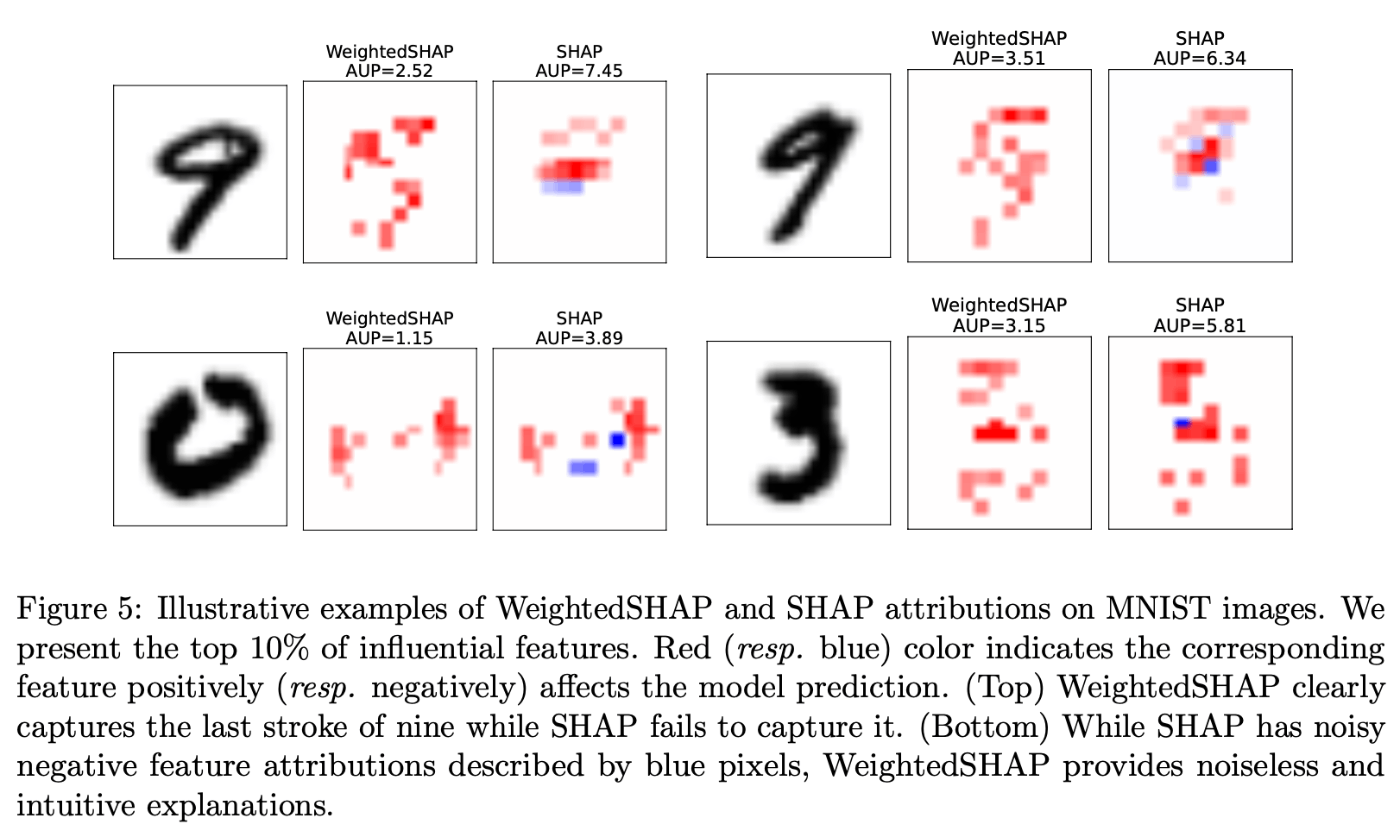
課題
元論文ではAUPを評価指標として使用し重みを最適化したが、特徴帰属法を評価するための統一的な指標は無いので、異分野にいる人は帰属概念を気にするかもしれない。したがって用途に最適化された限界貢献重み付けのバリエーションを開発することが今後の方向性としてある。
また、今回SHAPとWeightedSHAPを比較したが、[9] [10] はSHAPと他の評価指標を比較している。これは元論文を補完した研究になっている。
[9] Chih-Kuan Yeh, Cheng-Yu Hsieh, Arun Suggala, David I Inouye, and Pradeep K Ravikumar. On the (in) fidelity and sensitivity of explanations. Advances in Neural Information Processing Systems, 32, 2019.
[10] Neil Jethani, Mukund Sudarshan, Ian Covert, Su-In Lee, and Rajesh Ranganath. Fastshap: Real-time shapley value estimation. arXiv preprint arXiv:2107.07436, 2021a.
関連研究
大域的解釈(データセット全体の予測モデルに対する特徴の影響を説明するもの):
Stan Lipovetsky and Michael Conklin. Analysis of regression in game theory approach. Applied Stochastic Models in Business and Industry, 17(4):319-330, 2001.
回帰係数間の多重共線性によって分析が困難になることがある問題を、協調ゲーム理論のツールであるShaply値を使うことで、理論的に多重共線性の存在下でも一貫した結果が得られることを示した。
Qingyuan Zhao and Trevor Hastie. Causal interpretations of black-box models. Journal of Business & Economic Statistics, 39(1):272-281, 2021.
MLモデルから因果情報を抽出するため、Friedman’s partial dependence plotがPearl’s back-door adjustmentと同じ式で表されることから説き起こした。
Leo Breiman, Jerome H Friedman, Richard A Olshen, and Charles J Stone. Classification and regression trees. Routledge, 2017.
決定木モデルにおいて注目した特徴量による頂点の分割時、頂点の不純度の減少の和を重要度として測定した。
局所的な解釈(特定の予測値に対する特徴の影響を説明するもの):
Jianbo Chen, Le Song, Martin Wainwright, and Michael Jordan. Learning to explain: An information-theoretic perspective on model interpretation. In International Conference on Machine Learning, pages 883-892. PMLR, 2018. https://arxiv.org/abs/1802.07814
インスタンスごとの特徴選択として、与えられた各インスタンスに対して最も情報量の多い特徴のサブセットを抽出する関数を、選択された特徴と応答変数の間の相互情報を最大化するように学習する手法で、相互情報量に対する効率的な変分近似を提案した。
Scott M Lundberg, Gabriel Erion, Hugh Chen, Alex DeGrave, Jordan M Prutkin, Bala Nair, Ronit Katz, Jonathan Himmelfarb, Nisha Bansal, and Su-In Lee. From local explanations to global understanding with explainable ai for trees. Nature machine intelligence, 2(1):56-67, 2020.
GBDTなどの木ベースの非線形予測MLモデルの解釈可能性を「ゲーム理論に基づく最適な説明を計算するアルゴリズム」「局所的な特徴の相互作用効果を直接測定する説明」「各予測の局所的説明を組み合わせることに基づく大域的なモデル構造の解釈ツール」について医療機械学習問題に適用した。
Neil Jethani, Mukund Sudarshan, Ian Covert, Su-In Lee, and Rajesh Ranganath. Fastshap: Real-time shapley value estimation. arXiv preprint arXiv:2107.07436, 2021a. https://arxiv.org/abs/2107.07436
重み付き最小二乗から得られた学習とSGDを用いて、学習済みモデルをフォワード推論一発でSHAPを計算し高速化した。
DNNの解釈性に関するもの(勾配ベースである入力サンプルで評価された勾配を使うもの):
Karen Simonyan, Andrea Vedaldi, and Andrew Zisserman. Deep inside convolutional networks: Visualising image classification models and saliency maps. arXiv preprint arXiv:1312.6034, 2013. https://arxiv.org/abs/1312.6034
CNNの入力画像に対するクラススコアの勾配を計算することで、クラススコアを最大化する画像を生成しクラスの概念を可視化したり、与えられた画像とクラスに特化したクラス顕著性マップを計算することで、CNNの弱教師付きオブジェクトセグメンテーションに利用できることを示した。
Julius Adebayo, Justin Gilmer, Michael Muelly, Ian Goodfellow, Moritz Hardt, and Been Kim. Sanity checks for saliency maps. Advances in neural information processing systems, 31, 2018. https://arxiv.org/abs/1810.03292
DNNの解釈手法がどのような説明を提供できるかを評価する方法を提案し、視覚的評価のみに頼る手法ではなく、画像のエッジ検出から連想した方法で、線形モデルと単層のCNNを説明した。
Amirata Ghorbani and James Y Zou. Neuron shapley: Discovering the responsible neurons. Advances in Neural Information Processing Systems, 33:5922-5932, 2020.
DNNの予測と性能に対する個々のニューロンの寄与を定量化する提案手法Neuron Shapleyを使うことで、活性化パターンに基づく一般的なアプローチよりも効果的に重要な層を特定できる。特定した重要な層を可視化することでNNがどのように反応するか可視化することで解釈に役立つ。
SHAPは限界寄与に基づく方法なので、予測モデルの微分可能性を必要とせず、勾配ベースの方法よりも良い。
Shapley値のML問題への応用例:
Amirata Ghorbani and James Zou. Data shapley: Equitable valuation of data for machine learning. In International Conference on Machine Learning, pages 2242-2251. PMLR, 2019.
機械学習の評価として、予測器の性能に対する各訓練データの価値を定量化する尺度Data Shaplyを提案した。これはData Shaplyを効率的に推定するモンテカルロ法と勾配ベースの方法で、学習課題に対してどのデータが良いかについてleave-one-outや梃子スコアよりも強力で、また低いShaply値のデータは外れ値や破損しているものとして検出できる。
Ruoxi Jia, David Dao, Boxin Wang, Frances Ann Hubis, Nezihe Merve Gurel, Bo Li, Ce Zhang, Costas Spanos, and Dawn Song. Efficient task-specific data valuation for nearest neighbor algorithms. Proceedings of the VLDB Endowment, 12(11):1610-1623, 2019.
データの相対的価値を図るためにShaply値を使い、重み付けされていないK最近傍(KNN)分類器と回帰器に対して、全てのN個のデータ点のShaply値をO(NlogN)で正確に計算できることを示した。また、weigthed KNNなどの計算について、従来の近似アルゴリズムよりもO(N(logN)^2)倍効率的なモンテカルロ近似アルゴリズムを提案した。
Amirata Ghorbani, Michael Kim, and James Zou. A distributional framework for data valuation. In International Conference on Machine Learning, pages 3535-3544. PMLR, 2020.
Yongchan Kwon, Manuel A Rivas, and James Zou. Efficient computation and analysis of distributional shapley values. In International Conference on Artificial Intelligence and Statistics, pages 793-801. PMLR, 2021.
上2つの個々のデータの価値を測定するShaply値の手法をデータのランダム性を扱えるように拡張した。
他にもいくつかの使われ方がある。
Benedek Rozemberczki and Rik Sarkar. The shapley value of classifiers in ensemble games. In Pro- ceedings of the 30th ACM International Conference on Information & Knowledge Management, pages 1558-1567, 2021. https://arxiv.org/abs/2101.02153
2分類のアンサンブルにおける個々のモデルの価値を測るためのensemble gamesを考え、分類器の近似的なShaply値に基づいてペイオフを割り当てる効率的なアルゴリズムTroupeを提案した。このゲームにおけるShaply値はアンサンブルから高性能なモデルのサブセットを選択するための良い決定指標になり、アンサンブル決定器の効率的なpruningが可能になる。
Zelei Liu, Yuanyuan Chen, Han Yu, Yang Liu, and Lizhen Cui. Gtg-shapley: Efficient and accurate participant contribution evaluation in federated learning. arXiv preprint arXiv:2109.02053, 2021. https://arxiv.org/abs/2109.02053
Federated Learning(FL; 協調的な機械学習とデータプライバシー保護のギャップを埋める方法)では、参加者の個人データを公開することなくモデルの性能に対する参加者の貢献を評価する必要がある。Shaply値を計算するのはコストが大きいが、提案手法のGuided Truncation Gradient Shapley (GTG-Shapley)を使うことで、参加者の異なる組み合わせで何度も学習する代わりに、計算のための勾配更新とモンテカルロサンプリングを行う近似モデルを作ることで計算量を減らした。
Shaply公理の緩和は協力ゲーム理論の大きなトピックであり、元論文では効率公理の緩和のメリットを探索している。
Yongchan Kwon and James Zou. Beta shapley: a unified and noise-reduced data valuation framework for machine learning. arXiv preprint arXiv:2110.14049, 2021. https://arxiv.org/abs/2110.14049
Shaply値の効率性の公理を緩和することによってData Shaplyを一般化した、β Shaplyを提案した。
感想
SHAPは表データのみでなく、言語トークンを用いたモデルや画像などでも使えて、モデルを変更するのではなく特徴量のバリエーションから比較することができる。
WeightedSHAPを使えばSHAPよりも良い貢献度分解が可能になるため、使い得だと思った。


Discussion